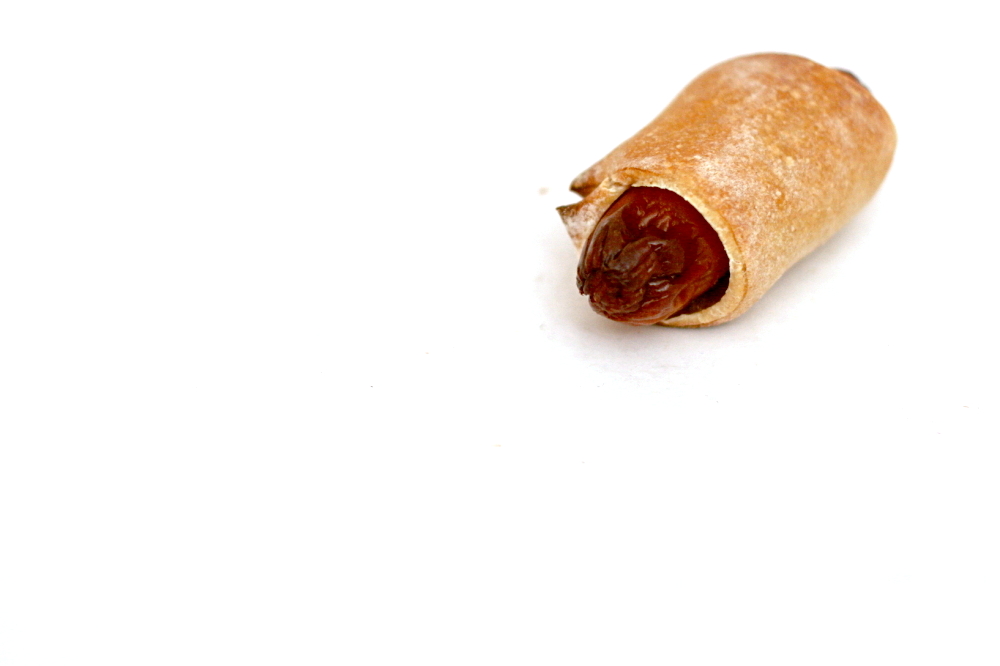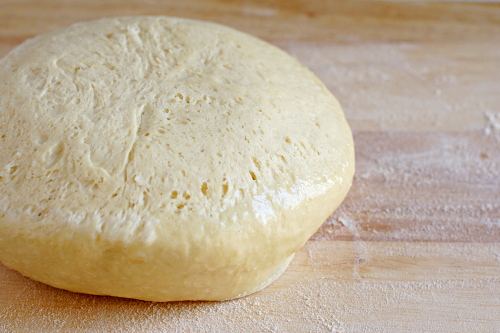Wow, who knew making Danish dough would be so easy? I’d previously considered making some sort of laminated dough, Danish or croissants or the like, but the number of steps involved with those recipes made me think that it would be an intense project requiring the better part of a day.
Not so. While the dough needs some babysitting, each step of rolling the dough flat and folding it into thirds, repeated three times, takes only a minute or two.
And good thing, because I made two separate Danish doughs. After I quickly scanned the recipe near the beginning of the month, I started thinking about what I wanted to fill my Danishes with. I settled on a savory and a sweet version, and it wasn’t until a few days before the posting date, when I looked closer at the recipe, that I realized that the dough itself was sweet and might not be a good match for the red pepper, Italian sausage, and parmesan I’d planned to fill it with. So I made the dough twice, once as written (except leaving out the cardamom, orange zest, and vanilla bean due to laziness) to be filled with cherries and almonds, and another time, reducing the sugar, increasing the salt, replacing the orange juice with water, and eliminating the vanilla extract.
I was very happy with both the sweet and the savory breads. I thought the dough might be flakier than it was, but perhaps this was due to the heat in my kitchen when I was working with the dough. Maybe the butter melted into the dough instead of remaining as separate layers. Or maybe that’s just how this dough is. Regardless, it was very tender. I did think that it needed a bit more salt, and this is something I’ll take into account in the future.
Overall, this was a great learning experience. Now that I know what’s involved with making a laminated dough, I feel much more confident trying similar recipes, like croissants and puff pastry.
Danish Braids
This is the recipe as I made it. You can find the original recipe at this month’s hosts’ sites.
Sweet Danish Dough:
¾ teaspoon active dry yeast
2 tablespoons whole milk
1½ tablespoons sugar
½ teaspoon vanilla extract
½ large eggs, chilled
1 tablespoon fresh orange juice
4 ounces all-purpose flour
¼ teaspoon salt
Savory Danish Dough:
¾ teaspoon active dry yeast
2 tablespoons whole milk
1 teaspoon sugar
½ large eggs, chilled
1 tablespoon water
4 ounces all-purpose flour
1/3 teaspoon salt
For the butter block (Beurrage)
8 tablespoons (1 stick) cold unsalted butter
2 tablespoons all-purpose flour
For the dough: Combine yeast and milk in the bowl of a mixer fitted with the paddle attachment and mix on low speed. Slowly add sugar, vanilla extract, egg, and orange juice. Mix well. Change to the dough hook and add the salt with the flour, 1 cup at a time, increasing speed to medium as the flour is incorporated. Knead the dough for about 5 minutes, or until smooth. You may need to add a little more flour if it is sticky. Transfer dough to a lightly floured baking sheet and cover with plastic wrap. Refrigerate for 30 minutes.
For the butter block: Combine butter and flour in the bowl of a mixer fitted with a paddle attachment and beat on medium speed for 1 minute. Scrape down the sides of the bowl and the paddle and then beat for 1 minute more, or until smooth and lump free. Divide in two and set aside at room temperature.
2. After the dough has chilled 30 minutes, turn it out onto a lightly floured surface. Roll the dough into a rectangle approximately 9 x 6.5 inches and ¼ inch thick. The dough may be sticky, so keep dusting it lightly with flour. Spread the butter evenly over the center and right thirds of the dough. Fold the left edge of the dough to the right, covering half of the butter. Fold the right third of the rectangle over the center third. The first turn has now been completed. Mark the dough by poking it with your finger to keep track of your turns, or use a sticky and keep a tally. Place the dough on a baking sheet, wrap it in plastic wrap, and refrigerate for 30 minutes.
3. Place the dough lengthwise on a floured work surface. The open ends should be to your right and left. Roll the dough into another approximately 6.5 x 9 inch, ¼-inch-thick rectangle. Again, fold the left third of the rectangle over the center third and the right third over the center third. No additional butter will be added as it is already in the dough. The second turn has now been completed. Refrigerate the dough for 30 minutes.
4. Roll out, turn, and refrigerate the dough two more times, for a total of four single turns. Make sure you are keeping track of your turns. Refrigerate the dough after the final turn for at least 5 hours or overnight. The Danish dough is now ready to be used. If you will not be using the dough within 24 hours, freeze it. To do this, roll the dough out to about 1 inch in thickness, wrap tightly in plastic wrap, and freeze. Defrost the dough slowly in the refrigerator for easiest handling. Danish dough will keep in the freezer for up to 1 month.
Cherry filling:
1 can cherries, drained, ¼ cup juice reserved
1.5-2 tablespoons sugar
½ tablespoon cornstarch
pinch salt
drop almond extract
¾ teaspoon brandy
toasted almonds
Stir sugar, cornstarch, and salt together in saucepan. Whisk in reserved cherry juice and wine. Cook, whisking frequently, over medium-high heat, until mixture simmers and thickens. Stir in almond extract and cherries. Cover and refrigerate until ready to use. Add to braid along with toasted almonds.
Sausage filling:
¼ pound sausage
½ red pepper, diced
Put sausage and ¼ cup water in medium-large skillet. Cook over medium-high heat until water evaporates and sausage cooks through and browns, about 7 minutes, breaking up large pieces. Remove sausage with slotted spoon. Add enough oil so that amount in skillet equals about 1 tablespoon. Add peppers and sauté until softened slightly, about 5 minutes. Season to taste with salt and pepper. Remove and set aside. Add to braid along with grated pecorino and parmesan cheese.
DANISH BRAIDS:
2 sets of Danish Dough
½ cup of each filling
Beat 1 large egg for egg wash
1. Line a baking sheet with a silicone mat or parchment paper. On a lightly floured surface, roll the Danish Dough into a 10 x 15-inch rectangle, ¼ inch thick. If the dough seems elastic and shrinks back when rolled, let it rest for a few minutes, then roll again. Place the dough on the baking sheet.
2. Along one long side of the pastry make parallel, 4-inch-long cuts with a knife or rolling pastry wheel, each about ¾ inch apart. Repeat on the opposite side, making sure to line up the cuts with those you’ve already made.
3. Spoon the filling you’ve chosen to fill your braid down the center of the rectangle. Starting with the top and bottom “flaps”, fold the top flap down over the filling to cover. Next, fold the bottom “flap” up to cover filling. This helps keep the braid neat and helps to hold in the filling. Now begin folding the cut side strips of dough over the filling, alternating first left, then right, left, right, until finished. Trim any excess dough and tuck in the ends.
Egg Wash
Lightly coat the braid with the egg wash. Spray cooking oil onto a piece of plastic wrap, and place over the braid.
Repeat with remaining braid and filling.
Proofing and Baking
1. Proof at room temperature or, if possible, in a controlled 90 degree F environment for about 2 hours, or until doubled in volume and light to the touch.
2. Near the end of proofing, preheat oven to 400 degrees F. Position a rack in the center of the oven. Brush braids with egg wash again.
3. Bake for 10 minutes, then rotate the pan so that the side of the braid previously in the back of the oven is now in the front. Lower the oven temperature to 350 degrees F, and bake about 15-20 minutes more, or until golden brown. Cool and serve the braid either still warm from the oven or at room temperature. The cooled braid can be wrapped airtight and stored in the refrigerator for up to 2 days, or freeze for 1 month.




























































